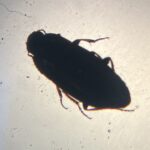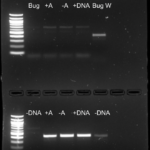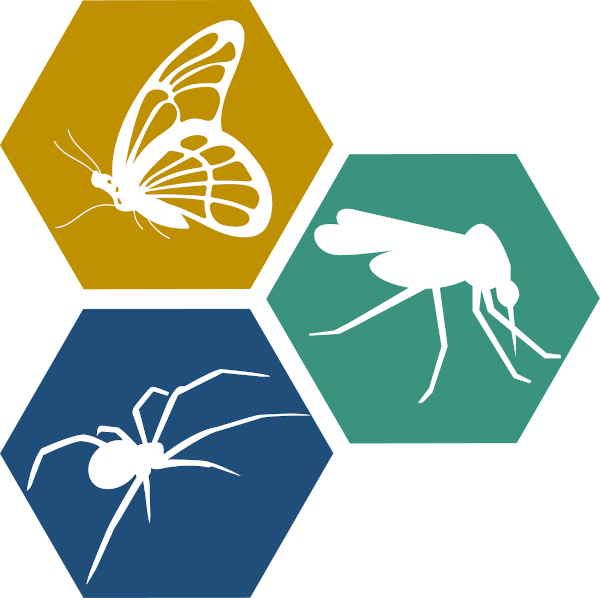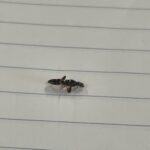Sample information |
|
| Picture |

|
|---|---|
| Location | |
| Collection date | 05/30/2025 |
| Captive / Cultivated? | Wild-caught |
| Group | Pingry School |
| Observations | I found the bug next to the birdfeeder at the Pingry School. It was in a patch of dirt, and there were numerous specimens of the same species. The arthropod has a smooth, oval body and is black. It is around 2 cm in length and 0.5 cm in width. |
| Putative identification | Arthropoda Insecta Hymenoptera Formicidae Camponotus Camponotus pennsylvanicus |
Methods |
|
| Extraction kit | DNeasy (Qiagen) blood and tissue kit |
| DNA extraction location | Abdomen |
| Single or Duplex PCR | Single Reaction |
| Gel electrophoresis system | Standard electrophoresis system |
| Buffer | 1X TAE |
| DNA stain | SYBR Safe |
| Gel images |

|
| Protocol notes | The first step was DNA extraction, then DNA purification, and then DNA elution. After that, I started PCR and created my gel. During my gel loading, I accidentally put my Wolbachia sample on the top row. It is the last well in the top row and is showing DNA at that well, signifying that there is Wolbachia present in my arthropod sample. After this, I did PCR purification and finally sequencing. |
Results |
|
| Wolbachia presence | Yes |
| Confidence level | High |
| Explanation of confidence level | I am confident that my bug has Wolbachia because in the gel, there is DNA present in the Wolbachia sample well and matches the positive control well. Also, in my sequencing of the Wolbachia sample, I have a 99.31% match with “uncontrolled Wolbachia”. This makes me confident in my findings. |
| Wolbachia 16S sequence | Download FASTA
NNNNNNNGNNGNNNNNNNNGTGTTGCATGGCTGTCGTCAGCTCGTGTCGTGAGATGTTGGGTTAAGTCCCGCAACGAGCN CAACCCTCATCCTTAGTTACCATCAGGTAATGCTGGGGACTTTAAGGAAACTGCCAGTGATAAACTGGAGGAAGGTGGGG ATGA
BLAST at The Wolbachia Project BLAST at NCBI
|
| Arthropod COI sequence | Download FASTA
NNNNNNNNNNNNNNNNNNNNNNNNGTTNANATTGGCTCCTCTATAAGAATAATCATTCGACTAGAGTTGGGATCTCCTGN NNNACTAATTCTTAATGATCAAACTTTCAATACCATCGTTACAAGTCATGCTTTTATTATAATTTTTTTTATAGTTATAC CTTTTATAATTGGGGGATTTGGTAATTGATTAATTCCACTTATACTAGGATCTCCTGATATAGCTTACCCTCGTTTAAAT AACATAAGATTTTGATTACTTCCCCCATCGATCTCCTTATTAATCCTAAGAAATTTTATTAATGAAGGATCTGGAACTGG TTGAACTATCTACCCCCCTCTATCATCAAATACCTTCCNNNNNGGCCCCTCTATTGACCTGACTATCTTTTCTCTCCATA TTGCTGGNATATCCTCAATTATAGGAGCAATCAATTTTATTTCAACNATTATAAATATACATAATTCCAATATTTCCCNN NATAAAATTCCATTATTATNATGATCTATTCTTATTACAGCTATTCTCCTTCTTCTGTCCCTACCTGTTCTAGCAGGGGC CTATTNNNTACTACTAACAGACCGAAAATCTTAATACTTCATTTTTTCGATCCCTCGGGGAGGANGAGATCCTATTTTTA TACCAACATTTATTTTGAATTTTTTGGGTCACCCTTGAAAGTTTAAN
BLAST at The Wolbachia Project BLAST at NCBI
|
| Summary | The Camponotus pennsylvanicus was found to be postive for Wolbachia. |
 European Paper Wasp
European Paper Wasp Woodworm Ant
Woodworm Ant